Tej pointed this out to me.
It seems that the newly implemented transliterated suggest feature on Google Hindi search is not exactly safe for kids (This feature is also available in the Telugu and Tamil searches, but then I don’t know the languages. Readers contribute).
What the suggest feature (announced on May 5, 2008) does is that while you search for a query using Hindi search you can input characters from the Roman script and Google will suggest queries based on what you type in.
Obviously, a very welcome feature, especially, for people who cannot type in Devanagari. But then there is something that might disturb some, particularly parents who are worried about what their kids might be inadvertently exposed to on the net.
Go to Google’s Hindi search page and type in any of the following letters – B, F, K, M, N, S or Y (this is correct at the time of posting this, but might – or might not – change in the near or distant future. The reasons are elaborated further down the post).
For “B” the suggested words include – बूर (bur) – Urdu slang for vagina. And then there is/are बूब्स (boobs).
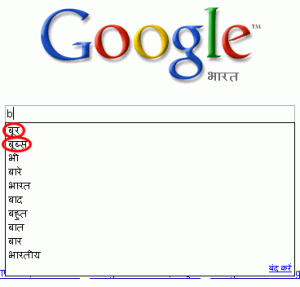
For “F”, फुद्दी (phuddi/fuddi) – Hindi slang for vagina
Type in “K” and you get the कामसूत्र (Kamasutra) – the ancient Sanskrit treatise advising rules for sensuous and sensual pleasure and love and marriage
Under “M” there is मस्तराम मुसाफ़िर कामोत्तेजक (Mastram Musafir Kamotejak) – roughly translates to “Jovial Traveller Lustful” and refers to (if I’m not mistaken) a – seemingly discontinued – Hindi blog on a once-popular series of sexually explicit fantasy stories by a pseudonymous author called Mastram that were very popular in north India in the 1980s and the 1990s.

It’s नंगी लड़की (nangi ladki) – nude girl – under “N”
The suggestions under “S” are almost exclusively devoted to सेक्स (sex) and related entities. For starters there’s सेक्स कहानी (sex kahani) – sex stories, then comes सेक्स करने (sex karne) – having sex, followed by सेक्स (sex). Then there’s सेक्स संबंधी (sex sambandhi) – sex related, with सेक्सी महिला (sexy mahila) sexy female – for some company with सेक्स के बारे (sex ke baare) about sex completing the ‘sexy’ list.
Typing in “Y” yields योनि (yoni) – this Sanskrit word has multiple – albeit related – meanings, in this context it would refer to the vagina.
When a kid is using this search feature to look for something else and suggestions appear, it would obviously tickle the child’s curiosity and lead him/her to explore that might not be suitable for his/her age.
Many parents use parental control software to regulate their children’s internet usage, but such regulations wouldn’t necessarily exist at all places where a child can access the internet from. And Google is an immensely popular online service provider.
Now why do such terms crop up? It is because:
So if people are searching for such non-kidsafe terms, it isn’t exactly Google’s fault. But again it is a vicious cycle, since the suggested terms might induce people to search for them more than they otherwise would and hence these terms would remain atop the Zeitgeist lists, for a long time.
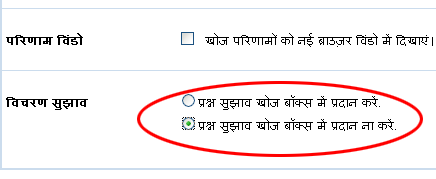 To be fair to Google, it does offer an option to shut this off. Clicking on the वरियताएं (Preferences) link, a user has the option to deselect प्रश्न सुझाव खोज बॉक्स में प्रदान करें radio button under विचरण सुझाव. But then it should have been deselected by default and a user could activate it voluntarily.
To be fair to Google, it does offer an option to shut this off. Clicking on the वरियताएं (Preferences) link, a user has the option to deselect प्रश्न सुझाव खोज बॉक्स में प्रदान करें radio button under विचरण सुझाव. But then it should have been deselected by default and a user could activate it voluntarily.
Moreover, Google’s Hindi search (or for the matter Bengali, Telugu, Marathi and Tamil) do not have the safe search option that is available in English and other languages.
Given the limited growth in the Indian language content on the web (compared to other languages) it might take a while for all the features to trickle in, till then keep you fingers crossed every time your child types in a “B” in the search form.

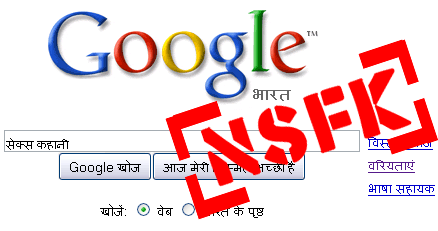
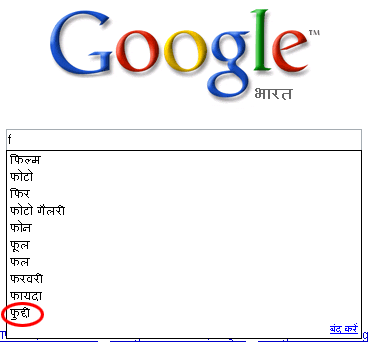


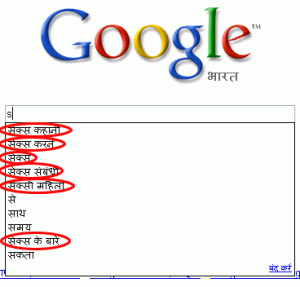



Thanks for posting this, I especially appreciate the English descriptions as I don’t speak Hindi. This happens with English searches too, even when you have safe search on and on “high setting”. Have turned off this otherwise useful feature, thanks for pointing out where it lives.